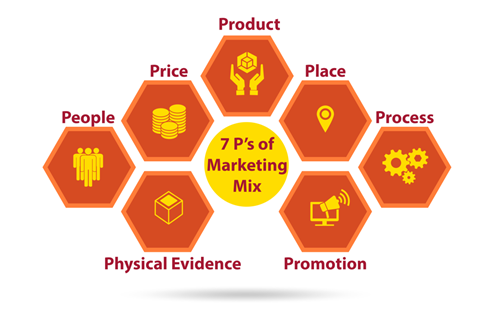How can we define the concept of Marketing Mix?
A marketing mix is referred to all those marketing activities which form a more significant part of any marketing strategy of an organisation. It is widely known to the world as 4Ps of marketing: product, price, placement, and promotion.
A great marketing strategy touches all the marketing areas that can achieve the desired marketing objective. The concept of the marketing mix emerged in the late 1940s by James Culliton, a professor of marketing at Harvard University, to understand how each marketing activity is driving the organisation towards achieving its marketing goals.
Later, the 4P marketing model was developed by McCarthy and was further modified and upgraded into 7P and 8P marketing mix models, which are used by the modern marketers of the 21st century.
Summary
- The marketing mix is believed to be the foundation of every marketing strategy that incorporates the 4Ps of marketing.
- Professor James Culliton first suggested the concept. However, the term marketing mix was coined by Neils Bordon.
- Later, many theorists have suggested extending the concept from 4Ps to 7Ps of marketing.

Image source: © Vichie81 | Megapixl.com
How did the concept of Marketing Mix emerge?
Professor James Culliton, the marketing professor at Harvard University, was the first to develop the marketing mix concept in the year 1948. He published an article describing the marketers as 'mixers of ingredients’. Later, Neils Bordon coined the term marketing mix, which was again refined and reshaped by E. Jerome McCarthy as the 4Ps of marketing in 1960.
The 4Ps of marketing forms the pillar of any marketing strategy. It helps the company to develop advertising and branding strategies and define its unique selling proposition.
What is McCarthy's 4ps of marketing?
Initially, the marketing mix was defined as the 4Ps of marketing by E. Jerome McCarthy, which soon became the essential elements of every marketing strategy. The 4Ps are:
- Product- It indicates a commodity or service from a company that aims to satisfy the customers. As the product designers put in a lot of effort to design and manufacture them, it is essential for marketers to have sound knowledge of their service or product as well as differentiate it from its competitors by defining the unique features of the product.
For example: As a marketer, you must ask these questions to yourself.

Other than these aspects, the marketers must also focus on complementary customer service after selling the products.
- Price- The price of the products is directly linked with the production cost. However, it also depends on the pricing set by the competitors. The marketers determine the cost of the products by analysing their real value and perceived value.
- Placement- Placement refers to the geographical location where you are willing to launch or sell your products. The location mainly says about your target customers, their needs, and demands.
For example, there will always be less demand for air conditioners in hilly areas as compared to the coastal regions. Similarly, there will always be a higher demand for room heaters in the hilly areas as compared to the coastal regions.
- Promotion- Promotion refers to how your products grab the audience's attention and communication through advertising, PR, sales promotion, and direct marketing. In this stage, the marketer also determines how to reach the audience (channel/ media marketing), what to communicate (message strategy), and when to communicate (message frequency).
What are the new components of the then existing marketing mix module?
Various theorists by the year 1980 were demanding for the expansion in the then existing marketing mix module, which would add three more components to it. Hence, the 7Ps of marketing are:
- Process: Process indicates the entire cycle starting from product manufacturing to its delivery.
- People and Psychology: People refer to all the potential customers of the brand and the psychology. It is vital for marketers to study the psychology of the people to know about their needs and demands precisely.
- Physical Evidence: Physical evidence can be defined as the environment in which the service takes place, space where the merchant and the customer communicates, symbols that remind the customer about your brand, and so on.

Image source: © Elnur | Megapixl.com
What are the benefits of following the Marketing Mix Model?
The marketing mix model is an efficient tool for beginners to cover all the fundamental areas of marketing strategy development. It also enables the marketers to have a holistic approach towards the overall market trend.

Image source: Copyright © 2021 Kalkine Media
What are the negative points of the Marketing Mix Model?
Initially, the marketing mix model was developed to optimise the marketing strategies. However, the traditional marketing mix model fails to offer every single personal level data to the marketers that they rely on in the current times. The needs of the individual are constantly changing depending upon the circumstance, which leads to the change in marketing efforts as well.
For example, the COVID 19 pandemic has witnessed a rapid change in consumer behaviour, making the marketers quickly adapt to the change and deliver products as per the customers' needs in that situation.
Moreover, with the increased popularity of digital marketing, it has become difficult for marketers to assess the ROI on the traditional marketing mix model.

Image source: Copyright © 2021 Kalkine Media
 Please wait processing your request...
Please wait processing your request...